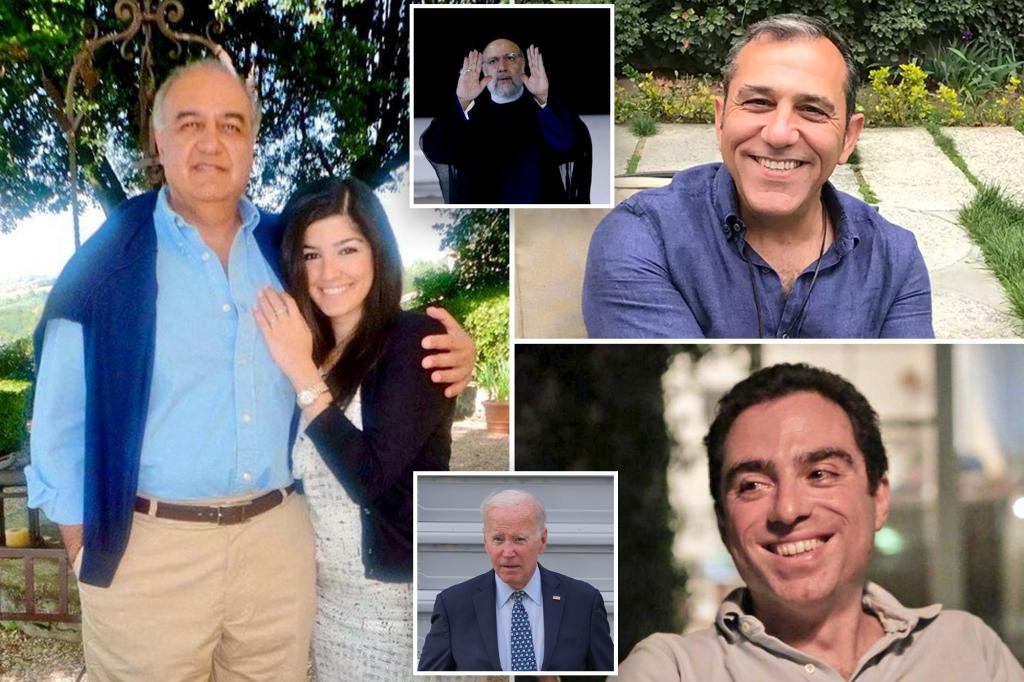Iran and the United States will exchange prisoners on Monday after about $6 billion once frozen in South Korea reaches Qatar, a key element of the planned exchange, officials said.
The planned exchange comes ahead of the United Nations General Assembly in New York, where Iran’s hardline President Ebrahim Raisi is due to address.
However, the exchange does not mean that tensions have eased between the US and Iran, which is now enriching uranium closer than ever to weapons-grade levels.
Iran’s Foreign Ministry spokesman Nasser Kanaani was the first to admit the exchange would take place Monday. He said the cash sought for the exchange was now in Qatar.
An individual with direct knowledge of the deal, who spoke to The Associated Press on condition of anonymity because the exchange had not yet been concluded, later said that both Iranian and US officials had been informed by Qatar that the money had been transferred from Switzerland. to the Gulf Arab countries.
 Emad Shargi – one of 5 US citizens currently incarcerated in Tehran’s Evin prison. Shargi Family Handout
Emad Shargi – one of 5 US citizens currently incarcerated in Tehran’s Evin prison. Shargi Family Handout
Kanaani made his comments during a nationally televised news conference, but the feed was cut off shortly after his statement without explanation.
“We witnessed the freezing of some Iranian assets in several countries including South Korea,” said Kanaani.
“As part of our active foreign diplomacy policy, fortunately, Iran’s frozen assets in South Korea have been released and God willing today those assets will begin to be fully controlled by the government and the country.”
 British-Iranian environmentalists Morad Tahbaz and Roxanne Tahbaz pose in this file photo obtained from social media. ROXANNE TAHBAZ via REUTERS
British-Iranian environmentalists Morad Tahbaz and Roxanne Tahbaz pose in this file photo obtained from social media. ROXANNE TAHBAZ via REUTERS
“On the subject of the exchange of prisoners, it will happen today, and five prisoners, citizens of the Islamic Republic, will be released from prison in the US,” Kanaani added.
“The five prisoners who are in Iran will be given to the US in return, based on their wishes. We expect both of these issues to be fully settled based on the agreement.”
He said two of the Iranian detainees will remain in the US.
 Siamak Namazi is seen posing in an undated photo. Twitter/Freethenamzis
Siamak Namazi is seen posing in an undated photo. Twitter/Freethenamzis
Iran’s news agency immediately reported, citing Kanaani, that the prisoner exchange would take place on Monday. No other information was immediately released by the agency and Washington declined to comment.
However, the Qatar Airways Airbus A320 landed on Monday morning at Tehran’s Mehrabad International Airport, where a previous prisoner release had taken place, according to flight tracking data analyzed by the AP. Qatar Airways uses Tehran’s Imam Khomeini International Airport for its commercial flights.
The announcement by Kanaani came weeks after Iran said that five Iranian-Americans were now under house arrest as part of confidence-building measures while Seoul allowed frozen assets, held in South Korean won, to be converted into euros.
 Iranian President Ebrahim Raisi walks during the official farewell ceremony for his trip to New York, at Mehrabad Airport in Tehran, Iran, on September 18, 2023. via REUTERS
Iranian President Ebrahim Raisi walks during the official farewell ceremony for his trip to New York, at Mehrabad Airport in Tehran, Iran, on September 18, 2023. via REUTERS
The money was then sent to Qatar, an interlocutor between Tehran and Washington in negotiations.
The planned exchange comes amid a massive American military buildup in the Persian Gulf, with US troops likely to board and control commercial ships in the Strait of Hormuz, through which 20% of all oil shipments pass.
The deal has also opened President Joe Biden to renewed criticism from Republicans and others who say the administration is helping boost Iran’s economy at a time when Iran poses a growing threat to US forces and Middle Eastern allies. That could carry over into his re-election campaign as well.
On the US side, Washington said the planned exchanges included Siamak Namazi, who was arrested in 2015 and later sentenced to 10 years in prison on internationally criticized espionage charges; Emad Sharghi, a venture capitalist who was sentenced to 10 years; and Morad Tahbaz, a British-American conservationist of Iranian descent who was arrested in 2018 and also received a 10-year sentence.
US officials have so far refused to identify the fourth and fifth prisoners.
The five detainees alleged by Iran were mostly held for allegedly trying to export materials to Iran.
 President Biden disembarks Air Force One at John F. Kennedy International Airport on September 17, 2023, in New York City.GC Images
President Biden disembarks Air Force One at John F. Kennedy International Airport on September 17, 2023, in New York City.GC Images
The final dollar amount from Seoul could be between $6 billion and $7 billion, depending on the exchange rate.
The cash represents money owed to Iran by South Korea – but not yet paid – for oil bought before the Trump administration imposed sanctions on such transactions in 2019.
The US argues that, once in Qatar, the money will be kept in a restricted account and can only be used for humanitarian goods, such as medicine and food.
 Neda Shargi, the sister of Iranian prisoner Emad Shargi, hugs former Syrian hostage Sam Goodwin before a press conference with the family of the American hostage now being held as a hostage on May 4, 2022, in Washington. AP
Neda Shargi, the sister of Iranian prisoner Emad Shargi, hugs former Syrian hostage Sam Goodwin before a press conference with the family of the American hostage now being held as a hostage on May 4, 2022, in Washington. AP
The transaction is currently permitted under American sanctions targeting the Islamic Republic over its burgeoning nuclear program.
Iranian government officials largely agreed with that explanation, although some insisted, without providing evidence, that there would be no restrictions on how Tehran spends the money.
Iran and the US have a history of exchanging prisoners since the 1979 takeover of the US Embassy and the hostage crisis following the Islamic Revolution.
 Iran’s Supreme Leader Ali Khamenei attends a ceremony at Imam Khomeini Husseinya to commemorate Arbaeen, in Tehran, Iran on September 6, 2023.Anadolu Agency via Getty Images
Iran’s Supreme Leader Ali Khamenei attends a ceremony at Imam Khomeini Husseinya to commemorate Arbaeen, in Tehran, Iran on September 6, 2023.Anadolu Agency via Getty Images
Their most recent major exchange came in 2016 when Iran reached a deal with world powers to curb its nuclear program in return for sanctions relief.
Start your day with everything you need to know
Morning Report delivers the latest news, videos, photos and more.
Four American prisoners, including Washington Post reporter Jason Rezaian, flew home from Iran at the time, and several Iranians in the US won their freedom. That same day, President Barack Obama’s administration sent $400 million in cash to Tehran.
Iran has received international criticism for targeting people with dual citizenship. The West has accused Iran of using foreign detainees as bargaining chips, a charge Tehran denies.
Talks on a key prisoner swap fizzled out after then-President Donald Trump unilaterally withdrew America from the nuclear deal in 2018. Starting the following year, a series of attacks and hijackings linked to Iran raised tensions.
Meanwhile, Iran’s nuclear program is now approaching weapons-grade levels. Although the head of the United Nations’ nuclear watchdog has warned that Iran now has enough enriched uranium to produce “several” bombs, it could take months more to build the arsenal and potentially scale it down to put it on a missile – if Iran decides to pursue one.
The US intelligence community has maintained its assessment that Iran is not pursuing an atomic bomb.
Iran has taken steps in recent months to resolve some issues with the International Atomic Energy Agency.
But progress in its program has led to fears of a wider regional conflagration because Israel, also a nuclear power, has said it will not allow Tehran to develop the bomb. Israel bombed both Iraq and Syria to stop their nuclear programs, making the threat all the more serious because it is also suspected of carrying out a series of assassinations targeting Iranian nuclear scientists.
Iran also supplies Russia with bomb-carrying drones that Moscow uses to target sites in Ukraine in its war on Kyiv, which remains another major bone of contention between Tehran and Washington.
Categories: Trending
Source: thtrangdai.edu.vn/en/



